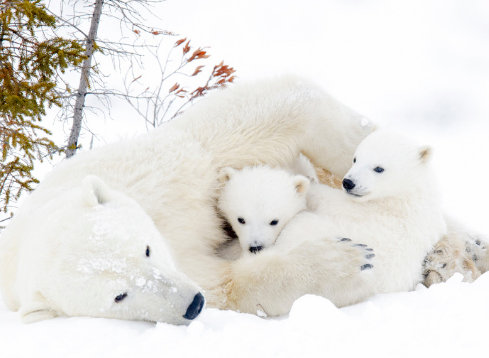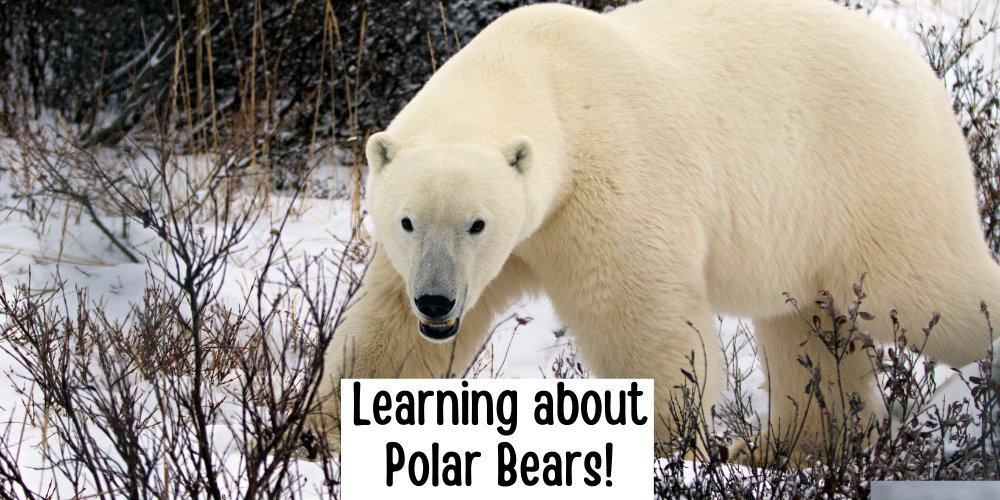| Scientific classification | |
|---|---|
| Kingdom: | Animalia |
| Phylum: | Chordata |
| Class: | Mammalia |
| Order: | Carnivora |
| Family: | Ursidae |
| Genus: | Ursus |
| Binomial Name | Ursus maritimus |
Habitat
Polar bears are only found in the Arctic. The most important habitats for polar bears are the edges of pack ice where currents and wind interact, forming a continually melting and refreezing matrix of ice patches and leads (open spaces in the sea ice).

Characteristics
Polar bears are built for the cold. Since these magnificent arctic animals live in one of the planet’s coldest environments, they depend on a thick coat of insulated fur, which covers a warming layer of fat. Fur even grows on the bottom of their paws, which protects against cold surfaces and provides a good grip on ice. The bear’s stark white coat provides camouflage in surrounding snow and ice. But under their fur, polar bears have black skin—the better to soak in the sun’s warming rays.
Hunting
These powerful predators typically prey on seals. In search of this quarry they frequent areas of shifting, cracking ice where seals may surface to breathe air. They also stalk ice edges and breathing holes. If the opportunity presents itself, polar bears will also consume carcasses, such as those of dead whales. These Arctic giants are the masters of their environment and have no natural enemies.
Reproduction
Between April and late June, as the snow begins to melt and the days become longer, adult male polar bears begin to find mates. After feeding throughout the summer and fall, pregnant females den by digging into deep snow drifts, in hills near sea ice or in banks of snow on the frozen sea. She excavates a small snow cave which provide protection and insulation from the Arctic elements. They give birth in winter, usually in December and usually to twins!
 Newborns are 30-35 centimeters long (12 to 14 inches) and weigh little more than half a kilogram (one pound). They are blind, toothless, and covered with short, soft fur. They are completely dependent on their mother for warmth and food. They grow rapidly on their mother’s rich milk (31% fat), and continue nursing for at least 20 months. Young cubs continue to live with their mothers for some 28 months to learn the survival skills of the far north. Females aggressively protect their young, but receive no help from their solitary male mates. In fact, male polar bears may even kill young of their species.
Newborns are 30-35 centimeters long (12 to 14 inches) and weigh little more than half a kilogram (one pound). They are blind, toothless, and covered with short, soft fur. They are completely dependent on their mother for warmth and food. They grow rapidly on their mother’s rich milk (31% fat), and continue nursing for at least 20 months. Young cubs continue to live with their mothers for some 28 months to learn the survival skills of the far north. Females aggressively protect their young, but receive no help from their solitary male mates. In fact, male polar bears may even kill young of their species.
Habits and Behaviors
Polar Bears communicate through body language, vocalizations and scent markings:
- Head wagging from side to side: A sign that polar bears want to play. Adult bears initiate play—which is actually ritualized fighting or mock battling—by standing on their hind legs, chin lowered to their chests, with front paws hanging by their sides.
- Nose-to-nose greetings: How a bear asks another bear for something, such as food. The guest bear will approach slowly, circle around a carcass, then meekly touch the feeding bear’s nose.
- Chuffing: A vocal response to stress, often heard when a mother bear is worried for her cubs’ safety.
- Scolding: Mother bears scold cubs with a low growl or soft cuff.
- Rushing: When a male approaches a female with cubs, she rushes toward him with her head lowered.
- Hissing, snorting, lowered head: Signifies aggression.
- Loud roars or growls: Communicates anger.
- Deep growls: Signifies a warning, perhaps in defense of food.
- Charging forward, with head down and ears laid back: Attack mode.
- Moving downwind of dominant bears: Signifies submission.
Diet and Eating Habits
Polar bears depend on the high-fat content in seal fat. The bears prey on both ringed and bearded seals across their range, but will take other prey when available.
A polar bear can eat 100 pounds of blubber in a single sitting. Ringed seals are the most accessible, especially to younger bears and females. Male polar bears also hunt larger bearded seals. When an adult bear is in good shape, polar bears often eat only the blubber in order to build up the fat reserves they need to sustain themselves between meals. They leave the carcass for scavengers such as arctic foxes, ravens, and other bears.
However, seals are not their only source of food. They are always alert to other food sources—including vegetation, geese, bird eggs, and even the occasional small mammal. Polar bears also occasionally feed on other Arctic marine mammals, including bowhead whale remains, the walrus, and the narwhal. Beluga whales or narwhals that become trapped in a small opening in pack ice can quickly become easy prey for bears.
Want more arctic animal resources? Check out…
- Arctic Ground Squirrel | Notebooking Pages
- Arctic Wolf | Notebooking Pages
- Caribou Notebooking Pages
- Bird of the Arctic – Willow Ptarmigan
Also check out these additional articles on Arctic animals…
________________________
>> Learn more about My Teaching Library! <<
BE the FIRST to know about NEW Products! Join the My Teaching Library FB group today!





